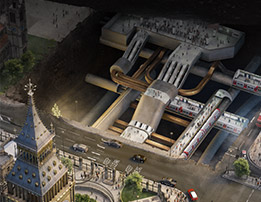
Increasing competition for surface space, targets for energy savings and for the broader objectives of sustainable development, point progressively towards greater, more diverse and better coordinated use of the subsurface.
In this way, supply and demand both favour increase in the extent and range of use of the ground beneath our feet.
(Abstract from "Tunnelling Technologies for the 3rd Millennium" Foreword by Sir Alan MuirWood ITA president 1974-1977)
Dive into the deepest structure on earth!
Transport
Tunnels for transport exist for centuries.
They have been developped both in urban environment for mass transit transports and in interurban environment mainly to cross mountains both for roads and railways.
The development of transport tunnel is still very active, notably in mass transit specifically in Asian countries, but also in European countries where new techniques both concerning construction and exploitation allow smaller towns to build a metro network.
In interurban environment, long base tunnels trend to replace summit tunnels and many underwater tunnels have been built or are at a project stage.
Urban Environment
In urban environment, the first tunnels have been built for mass transit networks.
Read moreInterurban Environment
Rail, road and navigation tunnels are beeing built for centuries. One of the most - if not the most- ancient tunnel of that type is the Malpas tunnel on the Canal du Midi in France built in 1776.
Read moreEnergy, Water & Telecommunication
More and more in urban areas but not only, utilities are built underground. First of them, and already in the ancient ages, sewers were built underground to avoid dissemintation of diseases and bad smells.
In Rome the "Cloaca maxima" has been built in the VI°BC.
Nowadays, more and more utilities are needed, electricity, communication, water, gaz, optic fiber.... They all need to be buried.
In non urban areas, the utilities are of an other type; they have been first associated with hydro power, but now they alos concern, hydrocarbon storage, nuclear waste storage, pipes.
Urban Utilities
With large concentrations of people in limited space, it has become necessary to utilize the subsurface for locating a growing number of services in urban environments.
Read moreNon Urban Utilities
Other Subsurface Facilities
Public Buildings
In a growing number of cases, public buildings are being built underground in some of the major cities all over the world.
Read moreGoods Storage
One of the big advantages of underground spaces is the high thermal inertia and the relatively limited cost of construction when the rock mass is of an adequate quality.
Read moreIndustrial Facilities
Even if it is not very common to locate industrial activity underground, on some occasion’s strategic or hazardous activities are carried out underground.
Read moreMilitary Facilities
The need of secrecy and the high strategic value of military installations make the use of the underground space of particular interest.
Read more